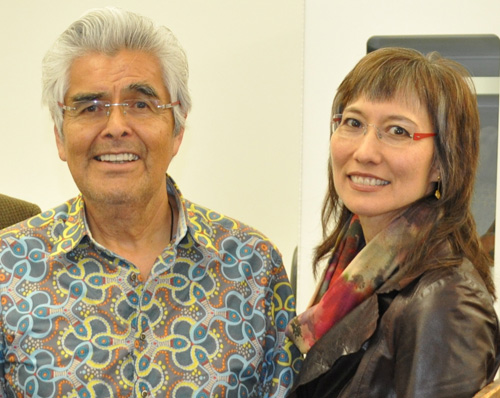
We recently spent the day with renowned Haida artist, Robert Davidson, looking at old Haida carvings in Penn Museum’s collection. Having flown across the country from Haida Gwaii, British Colombia (Canada!), Robert and his wife Terri-Lynn Williams-Davidson (a Haida attorney) arrived with their own photographer, Jack Litrell. Their goal was to interview and record Mr. Davidson speaking on video camera about masterworks of Haida art in the Penn Museum.
In advance of their travel, Davidson had looked carefully at our website to find the finest early 19th century examples in the collection. His video documentation will be used to teach students, apprentices, and Haida youth more broadly about the history, design, and artistic legacies of Haida carving traditions. It will also be used in legal depositions to fuel Haida efforts to reclaim tribal lands. Terri-Lynn works for White Raven Law Corporation, a Vancouver law firm lead by First Nations’ attorneys devoted to First Nations’ issues. The Museum is always pleased to accommodate requests in support of cultural and educational goals, but can not comment on the role of Davidson’s video in possible future litigation.

They began filming in our new Native American Voices gallery where Mr. Davidson looked carefully at an antler club, an extraordinary food bowl made of carved mountain goat horn, and an elegantly carved wooden dance rattle with painted human and animal attributes. After lunch, Davidson studied and then recorded his comments on the distinctive features of the Museum’s 30′ totem poles in the Kress Gallery Entrance.

After a second triple-shot of espresso in the Museum cafe, we moved into the Mainwaring Collections Study Room where, with assistance from Stephanie Mach and Bill Wierzbowski, Robert looked closely at a large and elegantly carved bentwood cedar chest.

Davidson examined each side of the box with great interest, noting the presence and variation of the Grandmother Mouse Woman within the formline design. He marveled at the carving of an unusually large raven rattle, and was inspired by a rare set of nearly 100 cedar bark oval shaped patterns used by neighboring Tlingit artists to map the “ovoid” shapes so distinctive in Haida and Tlingit formline design. Today Davidson makes his own ovoids out of paper, and just like the Tlingit example, folds his in half to ensure nearly perfect symmetry.
It was an honor to listen as Davidson generously shared his knowledge and to see his excitement as he experienced these old pieces. Careful and deliberate, he was deeply impressed by the rich detail and quality of the 19th century craftsmanship, and humbled in the presence of the old master carvers. Clearly Davidson is always learning. Challenged and alert to the nuances of his ancestor’s individual carving styles, Davidson was amused and even surprised to learn that in a couple of instances his predecessors used design techniques that he thought he had invented on his own.

Collection Object Number: 95-25-1





